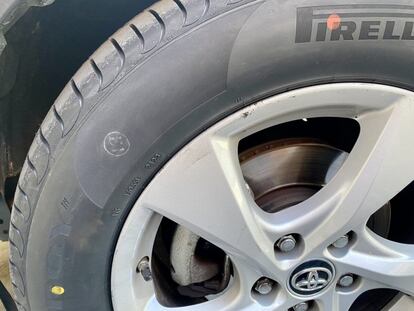Why do car tires have a yellow dot painted on them?
Automobile manufacturers are obliged to reflect in their different models the most important data for their subsequent marketing

The tire is one of the most important components in automobile driving. They are responsible for maintaining the vehicle’s grip on the asphalt, transmitting engine power to the ground, guaranteeing braking efficiency and maintaining precision in changes of direction.
In their production, manufacturers are obliged to reflect in their different models the most important data for their subsequent marketing. Thus, by means of standardized figures and codes, they certify the appropriate measurements for each vehicle, the date of manufacture, the maximum speed they can be subjected to etc.
But there are other less known specifications that are of vital importance for their correct assembly. These are the red dots, sometimes also in the shape of a triangle, which can be seen on the sides of the tire when they are new and which often disappear due to discoloration over time or when simply covered by dirt.
The red dot on the tire
The purpose of these red dots or triangles is to ensure the proper mounting of the tire on the car. In particular, they facilitate balancing, because they mark the maximum point of radial force variation (RFV), a defect that is not visible to the eye and is caused by the fact that no tire is perfect in terms of its shape, or the rigidity of its structure.
In addition, the rim on which the tire is mounted is not completely uniform, and some models have another mark at the point where its weight is greater and generates more centrifugal force when rotating on its axis. This is a mark that, when the tire is mounted, is taken into account together with the red dot where the tire is stiffer, which allows the mechanic to better balance the assembly by means of counterweights.
The correct balancing of the tires is very important. On the one hand, they eliminate possible vibrations in the wheels that affect driving comfort and cause abnormal and premature tire wear. On the other, defective wheel rotation can also have a negative effect on the vehicle’s handling at certain speeds and even damage the suspension elements themselves, such as shock absorbers.

Yellow and white markings
As well as the red markings, yellow marks can also be seen on some tires. And the points or triangles of these indicate the place where the tire is lighter, which is another useful reference point when performing a static balancing, making it coincide with the point on the rim where the inflation valve is located, in the absence of the balancing machine that specialized workshops use.
Some tire models also have small white circles marking the spot of minimum RFV — contrary to the maximum RFV — where the tire is most flexible.
However, this white marking can be misleading, because there are other manufacturers who mark their quality control approval in the same way.
All these markings are not mandatory and their use when fitting tires differs among brands. Therefore, it is advisable to find out about their exact use by contacting the manufacturer directly.
Sign up for our weekly newsletter to get more English-language news coverage from EL PAÍS USA Edition









































